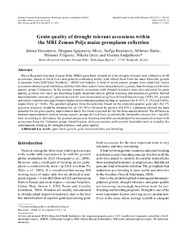Приказ основних података о документу
Grain quality of drought tolerant accessions within the MRI Zemun Polje maize germplasm collection
| dc.creator | Vančetović, Jelena | |
| dc.creator | Ignjatović-Micić, Dragana | |
| dc.creator | Božinović, Sofija | |
| dc.creator | Babić, Milosav | |
| dc.creator | Filipović, Milomir | |
| dc.creator | Grčić, Nikola | |
| dc.creator | Anđelković, Violeta | |
| dc.date.accessioned | 2019-05-16T12:17:34Z | |
| dc.date.available | 2019-05-16T12:17:34Z | |
| dc.date.issued | 2014 | |
| dc.identifier.issn | 1695-971X | |
| dc.identifier.uri | http://rik.mrizp.rs/handle/123456789/549 | |
| dc.description.abstract | Maize Research Institute Zemun Polje (MRI) gene bank created an elite drought tolerant core collection of 40 accessions, based on field trials and general combining ability with inbred lines from the main heterotic groups (Lancaster, Iowa Stiff Stalk Synthetic BSSS and Iodent). A total of seven genetic groups were identified. Seven accessions showed good combining abilities with three testers from chosen heterotic groups, thus forming a distinctive genetic group (Unknown). In the present research, accessions with drought tolerance were also analyzed for grain quality, as these two traits are becoming highly important due to global warming and population growth. Kernel macronutrients contents (oil, protein and starch) were determined using Near Infrared Spectroscopy (NIR). Oil, protein and starch contents were significantly higher in introduced populations than in landraces for 0.43%, 0.12% and 0.85%, respectively (p lt 0.01). The greatest progress from the selection based on the expected genetic gain (Delta G) for 5% selection intensity would be obtained for oil (14.74%) followed by protein (10.14%). Landraces showed the least potential for the grain quality improvement due to the lowest expected Delta G for the three macronutrients. The differences between macronutrient content among genetic groups defined them as potentially favourable sources for a specific trait. According to Delta G values, the greatest progress in breeding would be accomplished for increased oil content with accessions from the Unknown group. Identification of the accessions with several favorable traits is valuable for simultaneous breeding for drought tolerance and grain quality. | en |
| dc.publisher | Spanish Natl Inst Agricultural & Food Research & Technolo, Madrid | |
| dc.relation | info:eu-repo/grantAgreement/MESTD/Technological Development (TD or TR)/31028/RS// | |
| dc.rights | openAccess | |
| dc.rights.uri | https://creativecommons.org/licenses/by-nc/4.0/ | |
| dc.source | Spanish Journal of Agricultural Research | |
| dc.subject | gene bank | en |
| dc.subject | genetic gain | en |
| dc.subject | macronutrients | en |
| dc.subject | pre-breeding | en |
| dc.title | Grain quality of drought tolerant accessions within the MRI Zemun Polje maize germplasm collection | en |
| dc.type | article | |
| dc.rights.license | BY-NC | |
| dc.citation.volume | 12 | |
| dc.citation.issue | 1 | |
| dc.citation.spage | 186 | |
| dc.citation.epage | 194 | |
| dc.citation.other | 12(1): 186-194 | |
| dc.citation.rank | M22 | |
| dc.identifier.wos | 000333657200018 | |
| dc.identifier.doi | 10.5424/sjar/2014121-4392 | |
| dc.identifier.scopus | 2-s2.0-84897775817 | |
| dc.identifier.fulltext | http://rik.mrizp.rs//bitstream/id/2484/547.pdf | |
| dc.type.version | publishedVersion |


